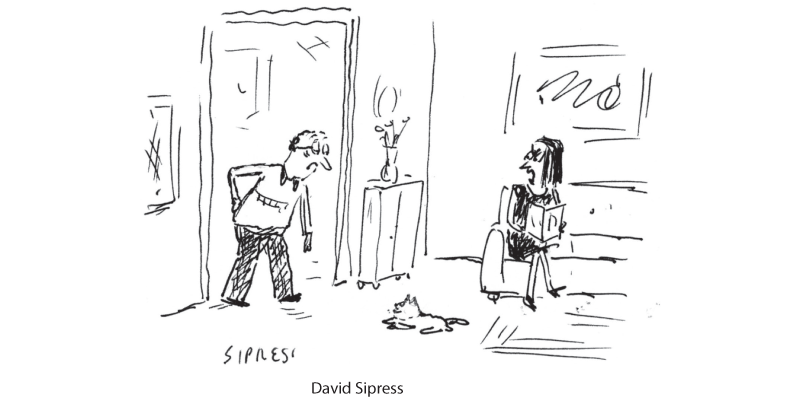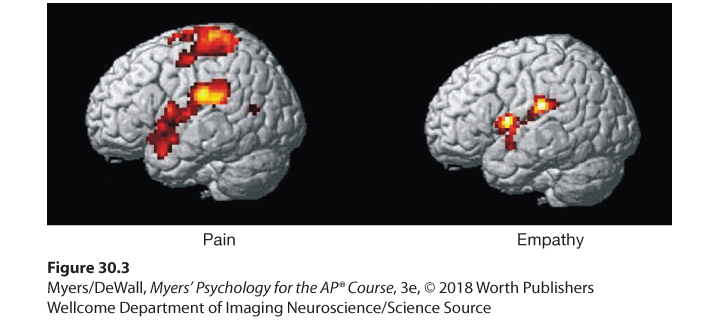Mirrors and Imitation in the Brain
In 1991, on a hot summer day in Parma, Italy, a lab monkey awaited its researchers’ return from lunch. The researchers had implanted wires next to its motor cortex, in a frontal lobe brain region that enabled the monkey to plan and enact movements. The monitoring device would alert the researchers to activity in that region of the monkey’s brain. When the monkey moved a peanut into its mouth, for example, the device would buzz. That day, as one of the researchers reentered the lab, ice cream cone in hand, the monkey stared at him. As the researcher raised the cone to lick it, the monkey’s monitor buzzed—as if the motionless monkey had itself moved (Blakeslee, 2006; Iacoboni, 2008, 2009).
The same buzzing had been heard earlier, when the monkey watched humans or other monkeys move peanuts to their mouths. The flabbergasted researchers, led by Giacomo Rizzolatti (2002, 2006), had, they believed, stumbled onto a previously unknown type of neuron. These presumed mirror neurons, they argued, provide a neural basis for everyday imitation and observational learning. When a monkey grasps, holds, or tears something, these neurons fire. And they likewise fire when the monkey observes another doing so. When one monkey sees, its neurons mirror what another monkey does. (For a debate regarding the importance of mirror neurons, which are sometimes overblown in the popular press, see Gallese et al., 2011; Hickok, 2014.)
Imitation is widespread in other species. As Module 83 describes, chimpanzees observe and imitate all sorts of novel foraging and tool use behaviors, which are then transmitted from generation to generation within their local culture (Hopper et al., 2008; Whiten et al., 2007). In one 27-year analysis of 73,790 humpback whale observations, a single whale in 1980 whacked the water to drive prey fish into a clump. In the years since, this “lobtail” technique spread among other whales (Allen et al., 2013).

“Your back is killing me!”
Mirror neurons at work?
So, too, with monkeys. Erica van de Waal and her co-researchers (2013) trained groups of vervet monkeys to prefer either blue or pink corn by soaking one color in a disgusting-tasting solution. Four to six months later, after a new generation of monkeys was born, the adults stuck with whatever color they had learned to prefer—and, on observing them, so did all but one of 27 infant monkeys. Moreover, when blue- (or pink-) preferring males migrated to the other group, they switched preferences and began eating as the other group did. Monkey see, monkey do.

Animal social learning Whacking the water to boost feeding has spread among humpback whales through social learning (Allen et al., 2013). Likewise, monkeys learn to prefer whatever color corn they observe other monkeys eating.
In humans, imitation is pervasive. Our catchphrases, fashions, ceremonies, foods, traditions, morals, and fads all spread by one person copying another. Children and even infants are natural imitators (Marshall & Meltzoff, 2014). By 8 to 16 months, infants imitate various novel gestures (Jones, 2007). By 12 months (Figure 30.2), they look where an adult is looking (Meltzoff et al., 2009). And by 14 months, children imitate acts modeled on TV (Meltzoff, 1988; Meltzoff & Moore, 1989, 1997). Even as 2½-year-olds, when many of their mental abilities are near those of adult chimpanzees, young humans surpass chimps at social tasks such as imitating another’s solution to a problem (Herrmann et al., 2007). Children see, children do.

Figure 30.2 Imitation
This 12-month-old infant sees an adult look left, and immediately follows her gaze (Meltzoff et al., 2009).
“ Children need models more than they need critics.”
Joseph Joubert, Pensées, 1842
So strong is the human predisposition to learn from watching adults that 2- to 5-year-old children overimitate. Whether living in urban Australia or rural Africa, they copy even irrelevant adult actions. Before reaching for a toy in a plastic jar, they will first stroke the jar with a feather if that’s what they have observed (Lyons et al., 2007). Or, imitating an adult, they will wave a stick over a box and then use the stick to push on a knob that opens the box—when all they needed to do to open the box was to push on the knob (Nielsen & Tomaselli, 2010).
Humans, like monkeys, have brains that support empathy and imitation. Researchers cannot insert experimental electrodes in human brains, but they can use fMRI scans to see brain activity associated with performing and with observing actions. So, is the human capacity to simulate another’s action and to share in another’s experience due to specialized mirror neurons? Or is it due to distributed brain networks? That issue is under debate (Fox et al., 2016; Gallese et al., 2011; Hickok, 2014; Iacoboni, 2008, 2009; Spaulding, 2013). Regardless, children’s brains do enable their empathy and their ability to infer another’s mental state, an ability that Unit IX, Developmental Psychology, will call theory of mind.
Our brain’s response to observing others makes emotions contagious. Our brain simulates and vicariously experiences what we observe. So real are these mental instant replays that we may misremember an action we have observed as one we have performed (Lindner et al., 2010). But through these reenactments, we grasp others’ states of mind. Observing others’ postures, faces, voices, and writing styles, we unconsciously synchronize our own to theirs—which helps us feel what they are feeling (Bernieri et al., 1994; Ireland & Pennebaker, 2010). Imitation helps us gain friends, leading us to mimic those we like (Chartrand & Lakin, 2013). We find ourselves yawning when they yawn, smiling when they smile, laughing when they laugh.
Seeing a loved one’s pain, our faces mirror the other’s emotion. But as Figure 30.3 shows, so do our brains. In this fMRI scan, the pain imagined by an empathic romantic partner has triggered some of the same brain activity experienced by the loved one actually having the pain (Singer et al., 2004). Even fiction reading may trigger such activity, as we mentally simulate (and vicariously experience) the experiences described (Mar & Oatley, 2008; Speer et al., 2009). In one experiment, university students read (and vicariously experienced) a fictional fellow student’s description of overcoming obstacles to vote. A week later, those who read the first-person account were more likely to vote in a presidential primary election (Kaufman & Libby, 2012). In other studies, students who read Harry Potter (the bestselling kid wizard series that masterfully modeled tolerance), reported less prejudice against immigrants, refugees, and gay people (Vezzali et al., 2015).

Figure 30.3 Experienced and imagined pain in the brain
Brain activity related to actual pain (left) is mirrored in the brain of an observing loved one (right). Empathy in the brain shows up in emotional brain areas, but not in the somatosensory cortex, which receives the physical pain input.